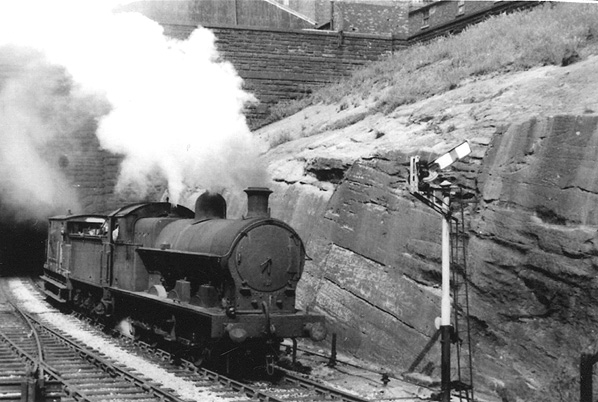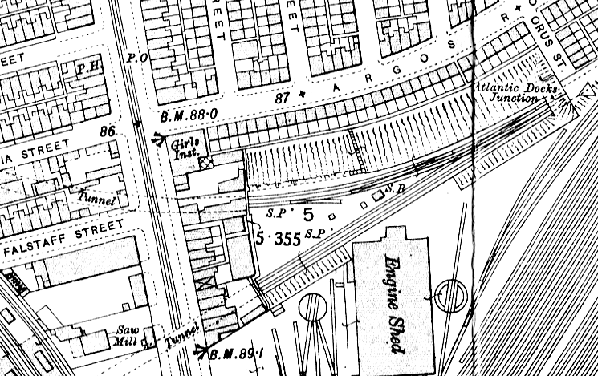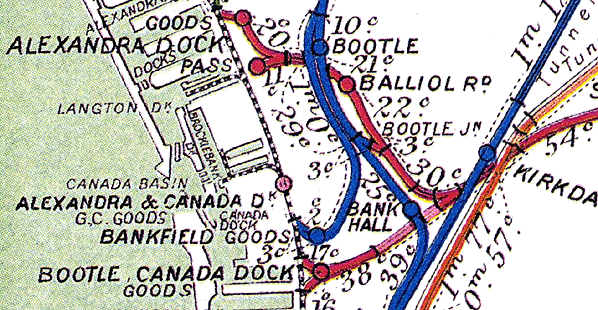 Atlantic Dock Junction looking north-east in 1930. In the distance can be seen Westminster Road Number 2 tunnel which took the Bootle branch under the Lancashire & Yorkshire railway at Kirkdale.
Atlantic Dock Junction looking north-east in 1930. In the distance can be seen Westminster Road Number 2 tunnel which took the Bootle branch under the Lancashire & Yorkshire railway at Kirkdale.
Photo by D Ibbotson |
Atlantic Dock Junction was on the LNWR Bootle branch. Originally there was just the double-track Bootle branch that linked Canada Dock to the Liverpool and Manchester railway. The line had opened through to Canada Dock on 15 October 1866. On 5 September 1881 a line opened from the Bootle branch to Alexandra Dock. It connected to the branch just to the east of Canada Dock tunnel forming the Atlantic Dock Junction. Originally the dock that became Alexandra was going to be called Atlantic Dock. Just before its formal opening it was decided to name it Alexandra after HRH Princess Alexandra who performed the opening ceremony of the dock. Although the LNWR changed the name of its station to Alexandra Dock it did not rename the junction.
 An engine and brake van emerge from Oriel Road tunnel and pass through
An engine and brake van emerge from Oriel Road tunnel and pass through
Atlantic Dock Junction in 1950.
|
Atlantic Dock Junction was in a deep cutting with sandstone-faced walls and, above them, grass embankments. To the east was the Westminster Road No. 2 tunnel (276yd) which carried the LNWR line under the Lancashire & Yorkshire Railway (LYR) at Kirkdale. To the west running west was Canada Dock tunnel (427yd) that took the original line to Canada Dock station. North of the Canada Dock tunnel was the Oriel Road tunnel (288yd) which curved northwards towards Bootle Junction.
To control the junction an LNWR Type 4 signal box was provided in the fork of the junction. It had a brick base and timber upper cabin and was provided with an 18-lever frame.
Atlantic Dock Junction became a busy railway location having both goods and passenger trains. Goods services were the most numerous, and they ran to all parts of the LNWR network. The junction became part of the London Midland & Scottish railway on 1 January 1923.
 Atlantic Dock Junction shown on a 1907 map. The junction was in a deep cutting behind the Lancashire & Yorkshire Railway Bank Hall locomotive shed.
Atlantic Dock Junction shown on a 1907 map. The junction was in a deep cutting behind the Lancashire & Yorkshire Railway Bank Hall locomotive shed.

The railways around Atlantic Dock Junction in the early 20th century. |
In 1950 there was an accident when a train heading north along the Alexandra Dock line rolled backwards from a steep climb up to Bootle Junction. There was a set of catch points on the down line that connected to a sand drag. Curiously the sand drag led directly to the signal box. The purpose of the catch points and sand drag was to stop a train that might roll backwards from running onto the junction. As the train rolled backwards it went through the catch points and onto the sand drag. The wagons did not stop and hit the signal box causing extensive damage. It was rebuilt as an LNWR Type 5 box retaining the original 18-lever frame.
 Atlantic Dock Junction seen looking north-east on 16 August 1971. The picture shows how the junction was located in a deep cutting.
Atlantic Dock Junction seen looking north-east on 16 August 1971. The picture shows how the junction was located in a deep cutting.
Photo by J A Sommerfield |
The line became part of British Railways (London Midland Region) on 1 January 1948. On 23 August 1976 the signal box was badly damaged by a malicious fire. It was replaced with a BR LMR Type 15 box which opened on 12 December 1976. The upper cabin was originally from New Lane. Once again the original frame was used. The new box also suffered an arson attack in April 1980. It was officially closed in July 1980 and was not replaced. The junction was controlled by a ground frame until Canada Dock officially closed on Sunday 12 September 1982. The line to Canada Dock was lifted shortly after and Atlantic Junction was no more. The line between Edge Hill and Alexandra Dock was still open in 2013 and was a busy freight route.
See also: Canada Dock, Canada Dock Goods, Bootle Balliol Road and Spellow stations. |

